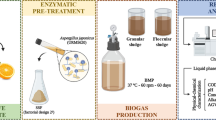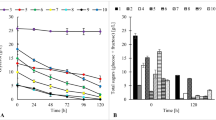Abstract
We conducted a study dealing with the economical application of sulphate-reducing bacteria (SRB) for the treatment of sulphate-rich wastewater. In this study, four types of frequently available fruit wastes were employed as carbon sources for economical cultivation of the SRB and consequent reduction of sulphate from artificially prepared sulphate-rich wastewater. The bacterial species employed in this study were isolated from a leading wastewater channel in Pakistan and characterized phenotypically as well as genotypically. The bacterial identities were proved after BLAST analysis and construction of phylogenetic tree. Among all of the SRB species employed for sulphate reduction, Desulfovibrio fructosovorans-HAQ2 was found as the leading sulphate reducer and reduced sulphate maximally to 29% (0.51 ± 0.02 g L−1), 76% (1.51 ± 0.07 g L−1), 41% (0.83 ± 0.02 g L−1), and 63% (1.25 ± 0.02 g L−1) using apple peelings, apple pomace, mango peelings, and watermelon rind, respectively, in a 60-day trial of anaerobic incubation. In the present study, apple pomace appeared as the most suitable carbon source only for Desulfovibrio fructosovorans-HAQ2, while any of the other three bacterial species could not reduce sulphate more than 34% using this substrate. However, on average, watermelon rind was found as the most appropriate carbon source for the cultivation of SRB and all the SRB species reduced sulphate efficiently in the range of 40–63% using this carbon source. Our findings of the present study prove the productive utility of fruit wastes for developing cost-effective and environmental-friendly remedial strategies.



Similar content being viewed by others
References
Ahmed I, Zia MA, Hussain MA, Akram Z, Naveed MT, Nowrouzi A (2016) Bioprocessing of citrus waste peel for induced pectinase production by Aspergillus niger; its purification and characterization. J Radiat Res Appl Sci 9(2):148–154
Aris AZ, Lim WY, Looi LJ (2015) Natural and anthropogenic determinants of freshwater ecosystem deterioration: An environmental forensic study of the Langat River Basin, Malaysia. In: Ramkumar M, Kumaraswamy K, Mohanraj R (eds) Environmental management of river basin ecosystems. Springer Earth System Sciences, Springer, Cham, pp 455–476
Armitage PD, Bowes MJ, Vincent HM (2007) Long-term changes in macroinvertebrate communities of a heavy metal polluted stream: the river Nent (Cumbria, UK) after 28 years. River Res Appl 23:997–1015
Aslam S, Hussain A, Qazi JI (2016) Dual action of chromium-reducing and nitrogen-fixing Bacillus megaterium-ASNF3 for improved agro-rehabilitation of chromium-stressed soils. 3 Biotech 6(2):1–11. https://doi.org/10.1007/s13205-016-0443-5
Barnes LJ (1998) Removal of heavy metals and sulphate from contaminated groundwater using sulphate-reducing bacteria: development of a commercial process. In: Sikdar SK, Irvine RL (eds) Bioremediation technologies. Lancaster, USA, pp 577–619
Barton LL (1995) Sulfate-reducing bacteria. Plenum Press, New York
Batool N, Shakir HA, Qazi JI (2015) Comparative growth potential of different Bacillus species on fruit peels. Punjab Univ J Zool 30(1):25–29
Bhatti MT, Latif M (2011) Assessment of water quality of a river using an indexing approach during the low flow season. Irrig Drain 60:103–114
Bratkova S, Koumanova B, Beschkov V (2013) Biological treatment of mining wastewaters by fixed-bed bioreactors at high organic loading. Bioresour Technol 137:409–413
Cary NC (2002) Statistics Version 901. SAS Institute Inc., USA
Cha JM, Cha WS, Lee J-H (1999) Removal of organo-sulphur odour compounds by Thiobacillus novellus srm, sulphur-oxidizing bacteria. Process Biochem 34:659–665
Costa MC, Duarte JC (2005) Bioremediation of acid mine drainage using acidic soil and organic wastes for promoting sulphate reducing bacteria activity on a column reactor. Water Air Soil Pollut 165:325–345
Crueger W, Crueger A (2005) Biotechnology: a textbook of industrial microbiology. Panima Publishing Corporation, New Delhi
Dvorak DH, Hedin RS, Edenborn HM, Mclntire PE (1992) Treatment of metal-contaminated water using bacterial sulfate reduction: results from pilot-scale reactors. Biotechnol Bioeng 40:609–616
Gibert O, De Pablo J, Cortina JL, Ayora C (2004) Chemical characterization of natural organic substrates for biological mitigation of acid mine drainage. Water Res 38:4186–4196
Gillespie IMM, Philp JC (2013) Bioremediation, an environmental remediation technology for the bioeconomy. Trends Biotechnol 31:329–332
Hayzoun H, Garnier C, Durrieu G, Lenoble V, Bancon-Montigny C, Ouammou A, Mounier S (2014) Impact of rapid urbanisation and industrialisation on river sediment metal contamination. Environ Monit Assess 186:2851–2865
Hussain A, Qazi JI (2012) Biological sulphate reduction using watermelon rind as a carbon source. Biologia (Pakistan) 58:85–92
Hussain A, Qazi JI (2016a) Application of sugarcane bagasse for passive anaerobic biotreatment of sulphate rich wastewaters. Appl Water Sci 6:205–211
Hussain A, Qazi JI (2016b) Metals-induced functional stress in sulphate-reducing thermophiles. 3 Biotech 6:1–8. https://doi.org/10.1007/s13205-015-0342-1
Hussain A, Qazi JI, Shakir HA (2014a) Implication of molasses as electron donor for biological sulphate reduction. Am J Environ Eng 4:7–10
Hussain A, Shakir HA, Qazi JI (2014b) Anaerobic biodegradation of sulphate employing animal manure as a cost effective growth substrate. J Anim Plant Sci 24:913–918
Hussain A, Hasan A, Javid A, Qazi JI (2016) Exploited application of sulfate-reducing bacteria for concomitant treatment of metallic and non-metallic wastes: a mini review. 3 Biotech 6(2):1–10. https://doi.org/10.1007/s13205-016-0437-3
Ihsanullah Abbas A, Al-Amer AM, Laoui T, Al-Marri MJ, Nasser MS, Khraisheh M, Atieh MA (2016) Heavy metal removal from aqueous solution by advanced carbon nanotubes: critical review of adsorption applications. Sep Purifi Technol 157:141–161
Jayalakshmi G, Bhavya KD, Saritha V (2016) Legitimate use of plant waste products for drinking water treatment. J Environ Res Develop 11(2):351–359
Joshi VK, Pandey A, Sandhu DK (1999) Fermentation technology for food industry waste utilization. In: Joshi VK, Pandey A (eds) Biotechnology—food fermentation (microbiology, biochemistry and technology). Educational Publishers and Distributors, New Delhi, pp 1291–1348
Jukes TH, Cantor CR (1969) Evolution of protein molecules. In: Munro HN (ed) Mammalian protein metabolism. Academic Press, New York, pp 21–132
Kaksonen AH, Plumb JJ, Franzmann PD, Puhakaka JA (2004) Effects of hydraulic retention time and sulphide toxicity on ethanol and acetate oxidation in sulphate reducing metal-precipitating fluidized-bed reactor. Biotechnol Bioeng 86:332–343
Kolmert Å, Wikström P, Hallberg KB (2000) A fast and simple turbidimetric method for the determination of sulfate in sulfate-reducing bacterial cultures. J Microbiol Methods 41:179–184
Kumar CSC, Mythily R, Chandraju S (2012) Studies on sugars extracted from water melon (Citrullus lanatus) rind, a remedy for related waste and its management. Int J Chem Anal Sci 3:1527–1529
Liamleam W, Annachhatre AP (2007) Electron donors for biological sulfate reduction. Biotechnol Adv 25:452–463
Malik A (2004) Metal bioremediation through growing cells. Environ Int 30:261–278
Martins M, Faleiro LM, Barros RJ, Veríssimo AR, Costa CM (2009a) Biological sulphate reduction using food industry wastes as carbon sources. Biodegradation 20:559–567
Martins M, Faleirob ML, Barros RJ, Veríssimo AR, Barreirosd MA, Costa MC (2009b) Characterization and activity studies of highly heavy metal resistant sulphate-reducing bacteria to be used in acid mine drainage decontamination. J Hazard Mater 166:706–713
Mulk S, Azizullah A, Korai AL, Khattak MNK (2015) Impact of marble industry effluents on water and sediment quality of Barandu River in Buner District, Pakistan. Environ Monit Assess 187:1–23. https://doi.org/10.1007/s10661-014-4221-8
Okoh AI, Trejo-Hernandez MR (2006) Remediation of petroleum polluted systems: exploiting the bioremediation strategies. Afr J Biotechnol 5:2520–2525
Ollivier B, Cord-Ruwisch R, Hatchikian EC, Garcia JL (1988) Characterization of Desulfovibrio fructosovorans sp. nov. Arch Microbiol 149:447–450
Pagnanelli F, Viggi CC, Cibati A, Uccelletti D, Toroa L, Palleschi C (2012) Biotreatment of Cr(VI) contaminated waters by sulphate reducing bacteria fed with ethanol. J Hazard Mater 199–200:186–192
Phiri O, Mumba P, Moyo BHZ, Kadewa W (2005) Assessment of the impact of industrial effluents on water quality of receiving rivers in urban areas of Malawi. Int J Environ Sci Technol 2:237–244
Postgate JR (1984) The sulfate-reducing bacteria. Cambridge University Press, Cambridge
Rockhold ML, Yarwood RR, Niemet MR, Bottomley PJ, Selker JS (2002) Considerations for modelling bacterial-induced changes in hydraulic properties of variably saturated porous media. Adv Water Resour 25:477–495
Sakan S, Dordević DS, Manojlović DD, Predrag PS (2009) Assessment of heavy metal pollutants accumulation in the Tisza river sediments. J Environ Manag 90:3382–3390
Singh R, Kumar A, Kirrolia A, Kumar R, Yadav N, Bishnoi NR, Lohchab RK (2011) Removal of sulphate, COD and Cr(vi) in simulated and real wastewater by sulphate reducing bacteria enrichment in small bioreactor and FTIR study. Bioresour Technol 102:677–682
Tamura K, Peterson D, Peterson N, Stecher G, Nei M, Kumar S (2011) MEGA: molecular evolutionary genetics analysis using maximum likelihood, evolutionary distance, and maximum parsimony methods. Mol Biol Evol 28:2731–2739
Tsukamoto TK, Killion HA, Miller GC (2004) Column experiments for microbiological treatment of acid mine drainage: low temperature, low pH and matrix investigations. Water Res 38:1405–1418
Wang Y, Liu RH, Fang DJ, Yu P, Wang JY, Tang AK (2013) Distribution and accumulation characteristics of heavy metals in sediments in southern sea area of Huludao City, China. Chin Geogr Sci 23:194–202
Zagury GJ, Kulnieks V, Neculita CM (2006) Characterization and reactivity assessment of organic substrates for sulphate-reducing bacteria in acid mine drainage treatment. Chemosphere 64:944–954
Acknowledgements
Financial support of Higher Education Commission, Pakistan for funding the first author under the “Indigenous Ph.D. 5000 Fellowship Program” is highly acknowledged.
Author information
Authors and Affiliations
Corresponding author
Ethics declarations
Conflict of interest
The authors report no conflicts of interest.
Rights and permissions
About this article
Cite this article
Hussain, A., Iqbal, M.A., Javid, A. et al. Application of Fruit Wastes as Cost-Effective Carbon Sources for Biological Sulphate Reduction. Iran J Sci Technol Trans Sci 43, 33–41 (2019). https://doi.org/10.1007/s40995-017-0436-1
Received:
Accepted:
Published:
Issue Date:
DOI: https://doi.org/10.1007/s40995-017-0436-1




